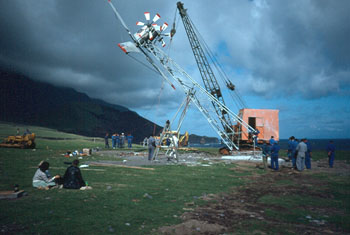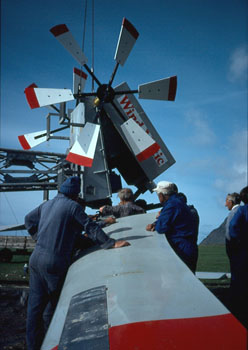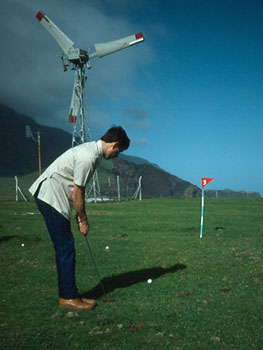Tristan da Cunha's 1980s Renewable Energy Projects
Tristan da Cunha 1980s Renewable Energy Projects |
|
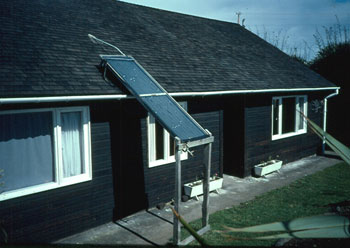 |
Solar Power The first phase of Tristan da Cunha's 1980s renewable energy project were a series of solar panels attached to the north-facing roofs of several Colt Bungalows that housed expatriate workers. This house was later destroyed in a fire but the panel in the photograph contributed no addition to heating of water by bottled gas when this 1982 photo was taken, despite claims that it worked previously! |
Wind Generator including extracts from Tristan Times |
|
|
In 1982 a very expensive wind generator, |
In November 1982 there was some guarded optimism for the project when 2910kw of electricity was produced. Nevertheless this represented a pay back of 23 years on capital costs without local labour or on-going maintenance which included fixing new side vanes (parts of the old pair blew away) and mending worn out disc breaks. |
|
Photos show the turbine being erected in April 1982
and as a backdrop to a Golf Match later in the year |
|
|
|
Unfortunately the turbine was destroyed
during a gale 408 days after being installed when a wild
but not exceptional gale backed from NE to WNW
early in the morning of 26th May 1983
and laid wreck to the Settlement's
most elegant and expensive landmark. The entire upper section including generating motor, main sails, cogwheel and side sails were wrenched from the metal tower and dispersed over a wide area. |
|
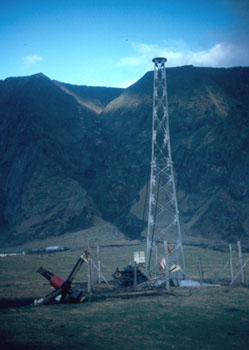 |
The photo left shows the turbine's gantry minus the three main blades which became airborne before threatening houses During the Island Council Meeting of 2nd August 1983 Chief Islander Albert Glass said that 'the wind turbine had never functioned properly from the day it was installed. There had been almost continuous problems with it and it was now damaged beyond repair. He considered that the island had been badly served in this matter, not only by Windmatic, but also by Cranfield and the British Government which had backed the scheme. Over £70,000 (of Tristan Government money) had been spent in a useless project and the Council wanted all or most of the money refunded.' The Chief Islander's view was unanimously agreed and negotiations started to arrange compensation. |
The March 1984 Tristan Times reported that Tristan was still encountering problems in receiving any compensation for its ill-fated £70,000 wind turbine venture. St Helena Governor John Massingham met with UK Minister of Overseas development Sir Neil Martin to lobby for compensation to be paid. The article continued 'The Tristan view is that the island was actively encouraged by the FCO and ODA (Overseas Development Administration) to go ahead with a project that went disastrously wrong.' It is understood no compensation was received for the failure of the wind generator. So scepticism of committing similar large capital expenditure by the Island Council is likely to continue. |
|

